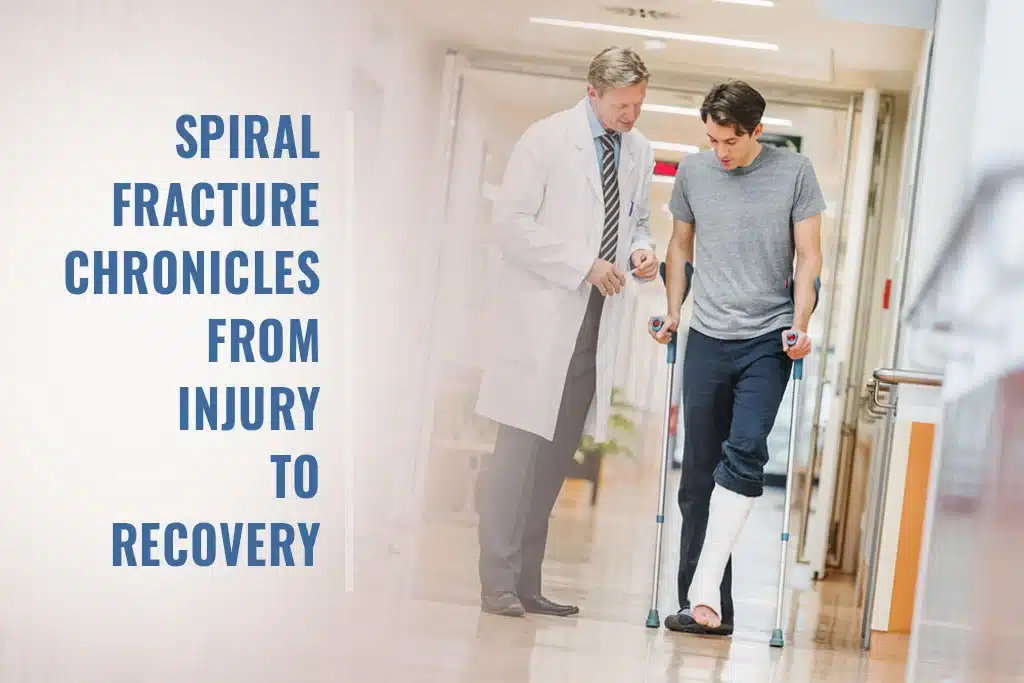
Certain types of bone fractures present greater complexity and pain than standard breaks. The Corkscrew Fracture stands as a rare but critical injury which demands immediate diagnosis alongside proper medical intervention. The particular characteristics of this fracture type remain misunderstood by many patients who require proper identification for successful healing and protection from future injuries. This guide provides complete information about the distinct characteristics of corkscrew fractures alongside essential steps for their management.
1. What Exactly Is a Corkscrew Fracture?
A corkscrew fracture represents a spiral fracture pattern which breaks bones by twisting them in a corkscrew pattern. The break occurs in a helical pattern which wraps around the bone structure because of intense rotational forces. A quick rotation of the leg with fixed foot position leads to this type of fracture.
- This fracture type most frequently impacts the long bones including the tibia and femur.
- Frequently seen in athletes or in accidents involving sudden rotational force.
- More difficult to heal than simple fractures due to the spiral pattern.
2. Causes of a Corkscrew Fracture
A corkscrew fracture emerges from particular incidents and specific movements rather than occurring spontaneously.
- Sports Injuries: The twisting movements during soccer and basketball games and skiing activities frequently lead to this type of injury.
- Car Accidents: An intense twisting force that occurs during a car collision can break the bone by causing it to rotate excessively.
- Falls: When a person lands with one body part stationary while another body part rotates suddenly this type of injury occurs.
The corkscrew fracture appears frequently among athletes along with people who experience high-impact accidents because of these causes.
3. Symptoms You Should Never Ignore
Early detection of these symptoms enables prevention of additional serious complications. Patients with corkscrew fractures typically experience these symptoms:
- The injury location produces intense sharp pain that intensifies at the fracture site
- The injury site swells while showing visible signs of abnormal shape
- The injured limb cannot support weight or perform standard movements
- The fracture location displays bruising which spreads to the surrounding area
Patients with these symptoms usually rush to urgent care clinics to obtain X-rays for fracture confirmation.
4. How Is a Corkscrew Fracture Diagnosed?
Medical practitioners rely on physical examinations to determine bone alignment along with tenderness and swelling assessment in their patients. Spiral fractures receive their primary diagnostic confirmation through imaging tests which doctors use as their main evaluation method.
- X-rays: Function as the primary diagnostic instrument to identify spiral patterns in bones.
- MRI scans: Sometimes ordered to check soft tissue involvement.
- CT scans: Helpful in complex fractures or when surgery is being planned.
Prompt and accurate diagnosis ensures the right treatment path is followed.
5. Treatment Options for Corkscrew Fracture
The degree of fracture severity determines the needed treatment. Options may include:
- Immobilization: During the healing process a cast or brace functions as an immobilization device to maintain bone position.
- Surgery: Surgical screws together with plates might become necessary for bone realignment in the most serious cases.
- Physical Therapy: After healing physical therapy serves as a vital treatment to regain strength along with mobility.
The duration of healing varies between multiple weeks and several months because of patient age and health status and their promptness in obtaining treatment.
6. Possible Complications If Left Untreated
A corkscrew fracture requires immediate attention because neglecting this condition will cause serious consequences.
- The bone will heal incorrectly (malunion) if the fracture receives inadequate treatment.
- The untreated injury will result in persistent pain as well as limited movement capabilities.
- The fracture site becomes more vulnerable to additional fractures because of the damage.
- Nerves and blood vessels located close to the fracture site may sustain damage from this condition.
The need for rapid diagnosis paired with immediate medical treatment serves as the essential path to achieving complete recovery
7. Prevention Tips: How to Avoid Corkscrew Fractures
Certain accidents develop without warning although established safety measures work to decrease their probability of occurrence:
- People should begin their physical activities by performing proper warm-up exercises before joining sports or exercise activities.
- All participants need to wear safety uniforms when participating in dangerous activities.
- Your body requires calcium with vitamin D to maintain healthy bones.
- You will defend yourself against injuries by using suitable lifting methods and correct twisting procedures alongside careful handling of challenging physical tasks.
The execution of preventive measures will lower the factors which promote bone development.
Why Understanding Corkscrew Fractures Matters
The information about this fracture type serves a dual purpose since it benefits both patients along with their parents as well as athletes and caregivers. Early recognition of symptoms along with prompt medical intervention stops permanent damage from developing. The presence of symptoms requires instant medical evaluation without delay for both you and your acquaintances.
Conclusion
A Corkscrew Fracture represents a critical injury which needs immediate medical intervention. Knowledge about its causes together with symptoms and treatment options enables better recovery outcomes. Seeking immediate medical attention at an urgent care center or hospital facility enables recovery of regular movement and stops potential complications. Knowledge about this condition and preventive practices will help you defend against this intricate fracture which causes severe pain.